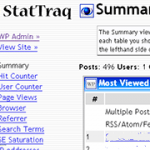One effective way to counter ad blindness is by rotating the ads display on the blog or website, distributing the ads impressions between various providers and thus providing variety to users. If you’re using WordPress blog, there is a simple plugin that allow you to do the rotation easily and automatically. The WordPress plug-in is AdRotator (no longer available, check out AdRotate instead), which allows bloggers to easily rotate the ads in a very convenient way. The AdRotator plugin will randomly select from a list of ads code of Google AdSense, Yahoo! Publisher Network (YPN), Commision Junction, Clicksor, Chitika, AuctionAds and etc specified in a text file at your chosen location. It can also be used to randomly include any other code or even to randomly display images, text messages etc.
If you’re not using WordPress, the AdRotator plugin won’t work out of the box, but you can always use and modify the PHP code to implement on your website.
Else, for both WordPress or other PHP powered websites, webmasters can also use an ad server with banner rotation support such as the free open source OpenAds (now Revive Adserver, previously known as phpAdsNew) to rotate Google Adsense, Valueclick, Tribal Fusion, and other advertising programs. You will need to install OpenAds on your web server though.
Modern alternatives include DoubleClick for Publishers (DFP) formerly called Google Dart, which can be used as an ad server.
Another alternative to rotate ads is by using display ads management system or default management system of an existing advertising network to rotate the ads. One popular option is Commission Junction SmartZones. The Smart Zones allows users to add several different banner advertisements from different advertisers and trigger the banner rotation on each page load with just a single set of code on website. Other possible ads network that support this feature include ValueClick and TribalFusion, though they more designed towards serving default. But that opens up the possibility of control by using eCPM, impressions and etc.
One last but least convenient option for those who rely on Google AdSense, is by rotating the colors of AdSense ad blocks. Google AdSense allows rotation of up to 4 AdSense color groups, and this feature is also useful to make it as if the ads have changed to the viewers.







